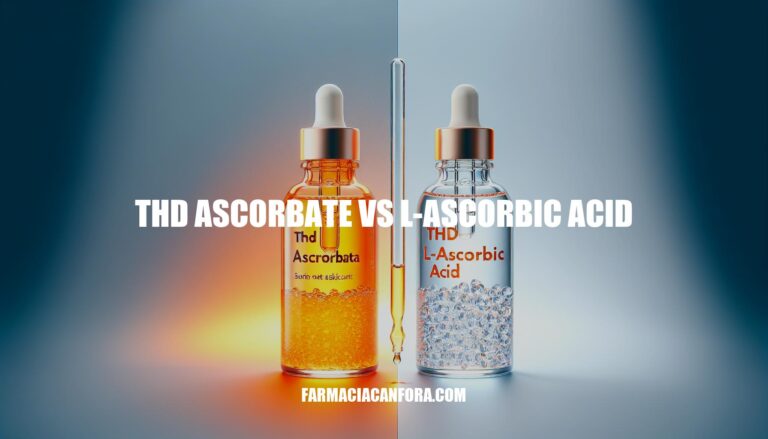When it comes to skincare, understanding the differences between Tetrahexyldecyl Ascorbate (THD Ascorbate) and L-Ascorbic Acid is crucial. Both are forms of Vitamin C, but they vary in stability, skin penetration, and potential for irritation. Knowing these differences can help you choose the right product for brighter, healthier skin.
Chemical Structure and Stability
Tetrahexyldecyl Ascorbate (THD Ascorbate) and L-Ascorbic Acid are both forms of Vitamin C, but they differ significantly in their chemical structures and properties.
L-Ascorbic Acid is the pure, water-soluble form of Vitamin C with the chemical formula
C6H8O6
. It is highly effective but unstable, prone to oxidation when exposed to air, light, or heat, which can reduce its efficacy in formulations.
THD Ascorbate, on the other hand, is a lipid-soluble derivative of Vitamin C. Its structure includes a long fatty acid chain, making it more stable and less prone to oxidation. This stability allows it to be used in a wider range of formulations, including oil-based products. Additionally, THD Ascorbate can penetrate the skin more effectively than L-Ascorbic Acid, reaching deeper layers and providing sustained benefits.
The enhanced stability and better skin penetration of THD Ascorbate make it a preferred choice in formulations aimed at long-term skin benefits and reduced irritation.
Skin Penetration and Efficacy
THD Ascorbate:
- Lipid-soluble.
- Penetrates deeper into the skin, reaching both the epidermis and dermis.
- More stable and less irritating.
- Higher penetration rate, surpassing L-Ascorbic acid by threefold at the same concentration.
L-Ascorbic Acid:
- Water-soluble.
- Limited to the epidermis.
- Less stable and more prone to irritation.
THD Ascorbate’s lipid-soluble nature allows for deeper penetration and potentially greater efficacy.
Benefits and Drawbacks
Here’s a concise comparison:
THD Ascorbate
Benefits:
- Stability: Highly stable, less prone to oxidation.
- Penetration: Lipid-soluble, penetrates deeper into the skin.
- Irritation: Less irritating, suitable for sensitive skin.
- Effectiveness: Effective in lower concentrations, good for long-term use.
Drawbacks:
- Potency: Less potent antioxidant compared to L-ascorbic acid.
- Cost: Generally more expensive.
L-Ascorbic Acid
Benefits:
- Potency: Most potent form of vitamin C, strong antioxidant properties.
- Effectiveness: Highly effective in brightening skin and boosting collagen production.
Drawbacks:
- Stability: Unstable, degrades quickly when exposed to light, air, and water.
- Irritation: Can be irritating, especially at higher concentrations.
- Penetration: Water-soluble, may not penetrate as deeply.
Usage in Skincare Products
Here are some examples:
THD Ascorbate
-
Serums:
- Dr. Dennis Gross C+ Collagen Brighten & Firm Vitamin C Serum: Uses THD ascorbate for deep penetration and stability, enhancing collagen production and reducing fine lines.
- Sunday Riley C.E.O. 15% Vitamin C Brightening Serum: Contains THD ascorbate to brighten skin and reduce dark spots with minimal irritation.
-
Moisturizers:
- Paula’s Choice C15 Super Booster: Combines THD ascorbate with other antioxidants to improve skin texture and tone.
- Murad Essential-C Day Moisture SPF 30: Uses THD ascorbate for antioxidant protection and hydration.
L-Ascorbic Acid
-
Serums:
- SkinCeuticals C E Ferulic: Contains L-ascorbic acid for potent antioxidant protection and collagen synthesis.
- Obagi Professional-C Serum 20%: Uses L-ascorbic acid to reduce signs of aging and brighten skin.
-
Moisturizers:
- La Roche-Posay Pure Vitamin C Face Serum: Features L-ascorbic acid to improve skin radiance and reduce wrinkles.
- Kiehl’s Powerful-Strength Line-Reducing Concentrate: Contains L-ascorbic acid to enhance skin firmness and smoothness.
Impacts on Skin Health
- THD Ascorbate: More stable, less irritating, penetrates deeper into the skin, suitable for sensitive skin, effective in reducing hyperpigmentation and boosting collagen.
- L-Ascorbic Acid: Highly potent, water-soluble, can be irritating, effective in brightening skin and providing antioxidant protection.
Tetrahexyldecyl Ascorbate (THD Ascorbate) vs. L-Ascorbic Acid: Understanding the Differences
Tetrahexyldecyl Ascorbate (THD Ascorbate) and L-Ascorbic Acid are both forms of Vitamin C, but they differ in stability, skin penetration, and potential for irritation.
THD Ascorbate is a lipid-soluble derivative with enhanced stability and better skin penetration, making it suitable for long-term skin benefits and reduced irritation. In contrast, L-Ascorbic Acid is highly effective but unstable, prone to oxidation when exposed to air, light, or heat.
The choice between the two forms depends on individual skincare needs: THD Ascorbate is ideal for sensitive skin, while L-Ascorbic Acid is preferred for its potent antioxidant properties and brightening effects.


